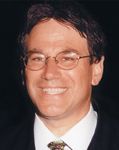Article
Circadian pattern of IOP may affect medical management of glaucoma
San Francisco—Both IOP and the rate of aqueous flow exhibit a circadian rhythm, and that is likely to have significant implications for the evaluation and treatment of patients with ocular hypertension and glaucoma, said Robert N. Weinreb, MD, at Glaucoma 2005.

"While it has been previously thought that IOP is highest in the morning and should be measured at 8 a.m. or 10 a.m. to capture the peak, more recent information indicates IOP is higher at night both in healthy individuals and in patients with glaucoma," said Dr. Weinreb, director, Hamilton Glaucoma Center, and Distinguished Professor of Ophthalmology, University of California, San Diego.
"Disease time-dependency is a well-known feature of several diseases, and the damage for glaucoma also may be time-dependent. Since peak IOP occurs during the night, considerable glaucomatous damage may occur during that period. Although other factors unquestionably contribute, including changes in the microcirculation, it seems logical to use medications that are effective at lowering IOP during the night as well as during the day," he added.
Over the past decade, Dr. Weinreb, in collaboration with John Liu, PhD, and other colleagues at the Hamilton Glaucoma Center, have been accumulating data about the circadian patterns of IOP and aqueous flow by studying patients in the setting of a 24-hour sleep laboratory. Those findings should be helpful for directing intervention to improve outcomes, Dr. Weinreb said.
A key feature of those studies is that "habitual" IOP was measured to reflect IOP that would be present during the usual course of daily activities.
"Because people are generally standing or sitting during the day, we measured sitting IOP during waking hours, but at night, IOP was measured in the supine position," Dr. Weinreb explained.
Using that methodology, the studies showed there are subtle differences between normal persons and glaucoma patients with respect to the time of peak IOP. For both groups, the highest level occurred in the nocturnal period, but peak IOP was generally measured just before waking in the normal group versus immediately after waking in the glaucoma patients. Studies performed with IOP measured in the supine position for 24 hours showed supine IOP also peaks in the nocturnal period and that during the daytime, supine IOP is higher than sitting IOP.
"Our studies show that two-thirds of the time, peak IOP occurs outside of usual office hours, and that supine IOP, not sitting IOP, provides the best estimate of peak IOP. Therefore, a single measurement of IOP during usual office hours may be insufficient for optimal glaucoma management. We need to consider measuring IOP at various times throughout the day and, perhaps, even measuring it in the supine position, which seems to give a better estimate of peak IOP than sitting IOP," Dr. Weinreb said.
Supine IOP may be measured in the office by tilting the examining chair back and waiting at least 2 minutes, he added.
Studies of 24-hour aqueous flow show that it is disproportionately represented during the day and decreases at night. The mean rate of aqueous flow decreases slightly from 3.0 μl/min between 6 a.m. and 12 p.m. to 2.7 μl/min from 12 p.m. to 10 p.m., and then drops by more than 50% during the nocturnal period from 10 p.m. to 6 a.m. when it is only 1.2 μl/min. Consequently, while 33% of the total volume of aqueous production occurs during the 6 hours between 6 a.m. and 12 p.m., only 17% of daily aqueous volume is produced during the 8 hours of the nocturnal period.
Clinical consequences




